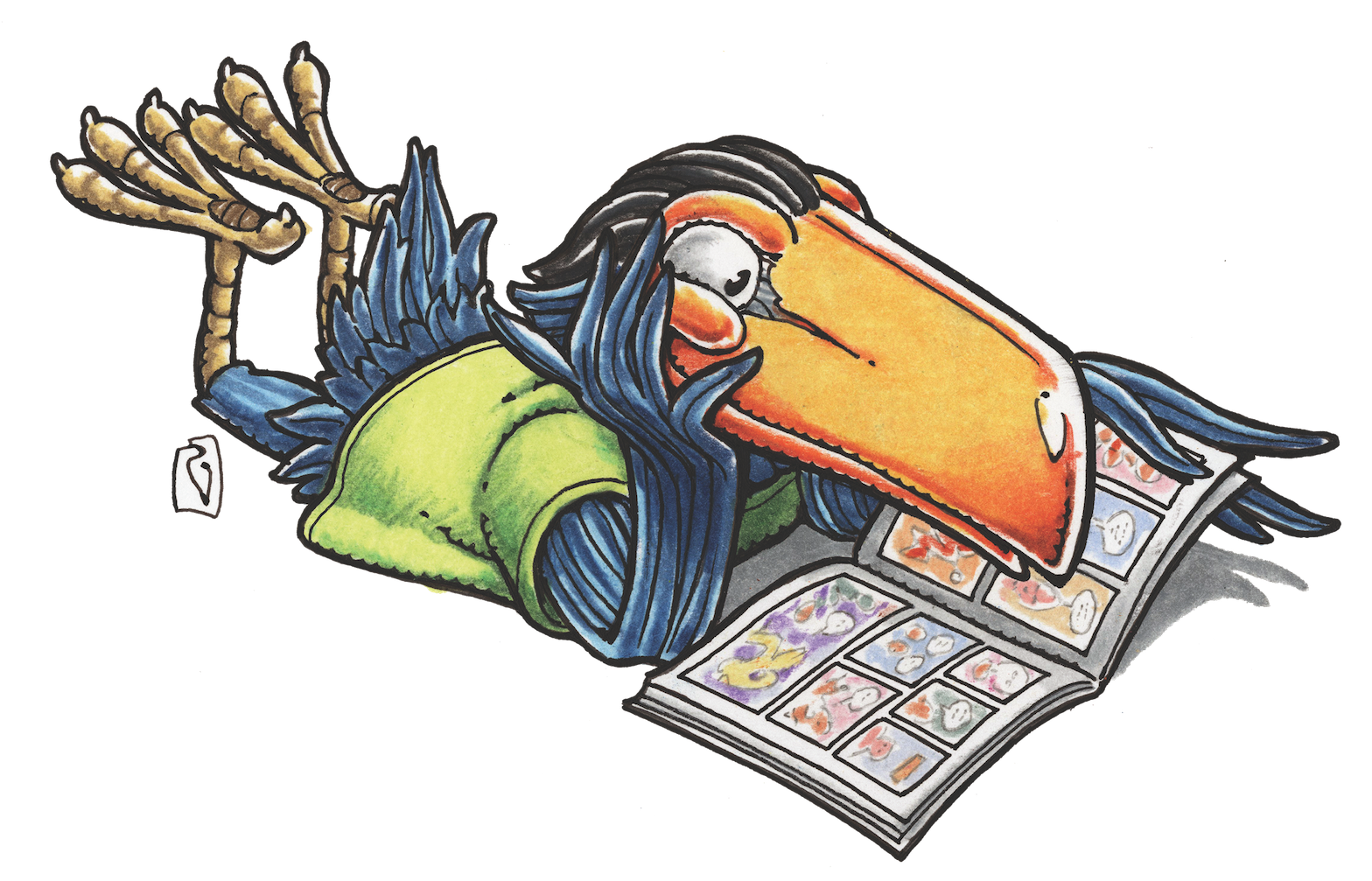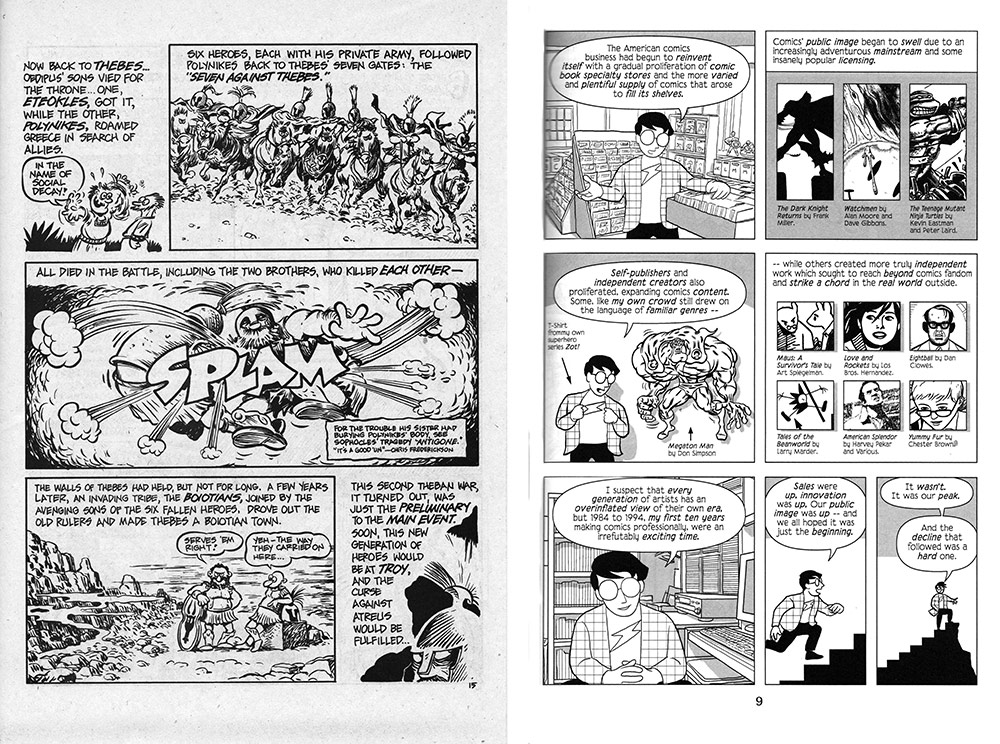MAGGIE’S WORLD BY MAGGIE THOMPSON
Maggie’s World 070: 4


A friend asked me recently what comics I’d recommend for her 4-year-old nephew. Thinking about the sort of comics I’d loved at that age—and comics that had entertained our kids 25 and 30 years later—my first suggestion was Jeff Smith’s Bone saga, begun in 1991. Noting that we’d be going to the library later that day, I said I’d show my friend what might be on the shelves there.
As we entered the children’s room, I repeated my recommendation of Bone, and the librarian shook her head and “Tsk”ed. “No!” she said and then librariansplained at me, “That’s in the YA collection.”
Background
The first comic book I can say with certainty that I read was Dell’s Four Color #103 (Easter with Mother Goose, April 1946). The second was Four Color #128 (Santa Claus Funnies, December 1946), by which time I was turning 4. The third was Dell’s Raggedy Ann + Andy #8 (January 1947). Understand that, when I say I “read” them, I mean that I perused them repeatedly, once Mom had read them to me.

But that’s one of the advantages in reading comic books: Most stories contain words and pictures, and, as Harvey Pekar used to say, there’s no limit to how good the words can be and no limit to how good the pictures can be. The bonus is that the pictures give clues to the words, and kids learn to read left to right, top to bottom, action following action.
Among my college courses were Education Department lessons in children’s literature and in teaching children to read. I worked in the Oberlin Public Library’s Children’s Department; after graduation, I worked for the Cleveland Public Library for two and a half years as a pre-professional assistant children’s librarian. (I couldn’t be a professional librarian, because I didn’t get a Master’s Degree in Library Science.) Oh—and then I read comic books to my two kids.
So, yeah, I’m not a professional librarian. But also, yeah, I do know something about children and comics.
What’s up with YA?
“YA” stands for “Young Adult.” When I worked at the library in Cleveland, the children’s collection was sorted roughly by categories of “Picture Books,” “Kindergarten through Second Grade,” and “Third and Fourth Grade.” The rest were just the remainder of the children’s collection. At whatever was deemed the appropriate age—12, maybe?—the patron got a card as an adult and had general access to all the books in the library.
A look at Wiki these days indicates that “YA” books are for readers 12-18 and that the category came to full flower in the 1970s. The essay even goes on to talk about “NA” books for (yes) “New Adult” readers, defined as people 18-30. As if … No, let’s move on.
Otherwise, I might end up suggesting a progression to “SA” for “Senior Adult” readers—which might take some of us back to picture books again.
In any case, the proverbial “All Ages” category that served so well for so long may no longer exist.
Except for comic books, doggone it.
Looking back at the comics available to my 4-year-old self in 1947, it seems clear that opportunities for entertainment were not limited to funny bunnies and talkative dolls. And I think that what disturbed me about the conversation at the library was the idea that Bone should be kept strictly away from a 4-year-old kid. It seems to me that one of the guiding spirits of reading for pleasure is encouraging kids to look at all the former “All Ages” comics to see what each finds of most interest.

Guidelines
That doesn’t mean that it’s not a good idea to have a framework of recommendation.
However, Randall W. Scott in Comics Librarianship: A Handbook (1990) discussed the challenges in comics classifications in that era, and the situation has grown even more complex since then, with the outpouring of material released in the ensuing quarter of a century.
Movies are now evaluated as General, Parental Guidance Suggested, Parents Strongly Cautioned, Restricted, and Adults Only. Keeping in mind that life itself can be “PG,” Larry Gonick’s groundbreaking Cartoon History of the Universe was only the first of his cartoon handbooks that could simultaneously entertain and inform. His magnificent comics guides on a variety of subjects may have passages that some parents might want to save until their less mature readers are a bit older.
Heck, I’d buy the wonderful Grammar Pack of posters by The Oatmeal (Matthew Inman) for my local school, were it not for passages that might make its teachers hesitate. “If you find yourself getting confused, try stripping down your sentence to just the essentials. I don’t know or care who/whom you punched in the butt.” And so on. (Memo to self: Maybe I should ask the teachers—because the lessons are both clear and memorable.)
In 2012, Scott Robins and Snow Wildsmith compiled A Parent’s Guide to the Best Kids’ Comics—and, yes, they put Bone in “Grade Level 6-8.” But note their “How to Use This Book” passage: “These grade levels are general guides and should not discourage readers from reading ‘up’ or reading ‘down,’ depending on their own personal reading levels, comfort levels, and/or interests.” Exactly.
Oh, Go Ahead and Share
Adults can enjoy Andy Runton’s wordless Owly stories—even while 4-year-olds can explain to them what’s going on—and it was one of those books that I finally handed to my friend. But, yes, adults can also read some of the “YA” comics to those 4-year olds, while they share the fun.
In June 1949, when I was 6, Mom wrote an essay to promote comics to her friends. She concluded by recommending Carl Barks’ “Lost in the Andes” Donald Duck story, then on sale. “We do seem to have accumulated a number of Superboy, Wonder Woman, and Bat Man opera, but these do not hold the attention of our six-year-old for more than five or six readings. Even Raggedy Ann [comics] can beat that.”
Which is to say that an excellent approach to what are now dignified with the term “graphic novels” is to turn the kids loose on what’s out there—and see what they like.
Hey, Free Comic Book Day is just a month away, on May 4 this year. That would be a great day to start finding what kids might like best, if you haven’t done so already.
Maggie’s World by Maggie Thompson appears the first Tuesday of every month here on Toucan!